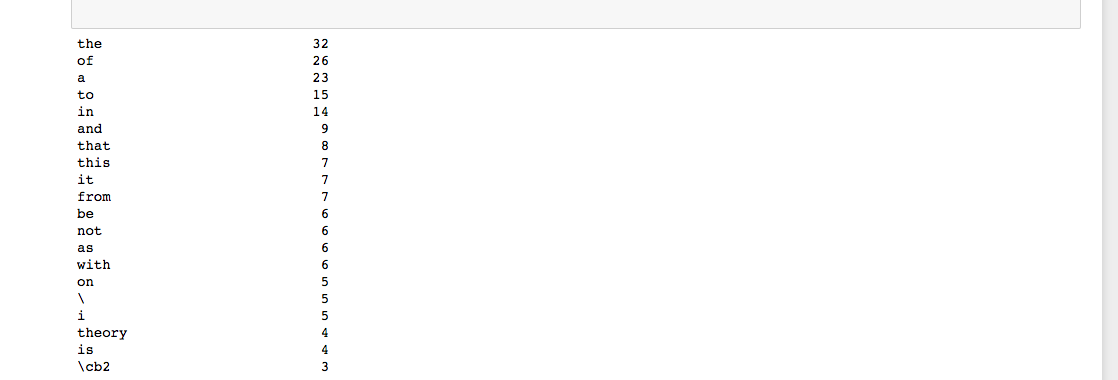1、统计英文单词,
# 1.准备utf-8编码的文本文件file(已在文件夹中定义了 一个名叫“head.txt.rtf”文本文件,详情请见截图)
def getTxt(): #3对文本预处理(包括)
txt = open('head.txt.rtf').read() #2.通过文件读取字符串 str
txt = txt.lower()#将所有的单词全部转化成小写
for ch in ",.!、!@#$%^'": #将所有除了单词以外的符号换成空格
txt.replace(ch, ' ')
return txt
#4、分析提取单词
txtArr = getTxt().split()
#5、单词计数字典
counts = {}
for word in txtArr:
counts[word] = counts.get(word, 0) + 1
#6、将字典转换为列表
countsList = list(counts.items())
countsList.sort(key=lambda x:x[1], reverse=True)
#8.输出TOP(20)
for i in range(20):
word, count = countsList[i]
print('{0:<20}{1:>10}'.format(word,count))

用到的知识点, split
str.split(str="", num=string.count(str)).
- str -- 分隔符,默认为所有的空字符,包括空格、换行(\n)、制表符(\t)等。
- num -- 分割次数。
-
实例: #!/usr/bin/python str = "Line1-abcdef \nLine2-abc \nLine4-abcd"; print str.split( ); print str.split(' ', 1 ); 输出: ['Line1-abcdef', 'Line2-abc', 'Line4-abcd'] ['Line1-abcdef', '\nLine2-abc \nLine4-abcd']
counts.get(word, 0) + 1:这个表达式代表的意思是,统计counts中的单词数,如果有word,就+1,没有word就返回0;这是一个统计单词数的方法,虽然统计完后,没有直接方法放到字典中,但它确实存在。
counts.items():以列表返回可遍历的(键, 值) 元组数组
实例:
#!/usr/bin/python
# coding=utf-8
dict = {'Google': 'www.google.com', 'Runoob': 'www.runoob.com', 'taobao': 'www.taobao.com'}
print "字典值 : %s" % dict.items()
# 遍历字典列表
for key,values in dict.items():
print key,values
结果:字典值 : [('Google', 'www.google.com'), ('taobao', 'www.taobao.com'), ('Runoob', 'www.runoob.com')]
Google www.google.com
taobao www.taobao.com
Runoob www.runoob.com
countsList.sort(key=lambda x:x[1], reverse=True):在这道题中,显然是排序,以从大到小的顺序排列,但有了lambda x:x[1]以后,就是以元组中的第二个元素来进行排序,显然第二个元素也会带动第一个元素。这样就可以,将列表中每个元组也排序了。后面的reverse = true是从大到小排列,false则反之。
range(start, stop[, step]):
- start: 计数从 start 开始。默认是从 0 开始。例如range(5)等价于range(0, 5);
- stop: 计数到 stop 结束,但不包括 stop。例如:range(0, 5) 是[0, 1, 2, 3, 4]没有5
- step:步长,默认为1。例如:range(0, 5) 等价于 range(0, 5, 1)
>>>range(10) # 从 0 开始到 10 [0, 1, 2, 3, 4, 5, 6, 7, 8, 9] >>> range(1, 11) # 从 1 开始到 11 [1, 2, 3, 4, 5, 6, 7, 8, 9, 10] >>> range(0, 30, 5) # 步长为 5 [0, 5, 10, 15, 20, 25] >>> range(0, 10, 3) # 步长为 3 [0, 3, 6, 9] >>> range(0, -10, -1) # 负数 [0, -1, -2, -3, -4, -5, -6, -7, -8, -9] >>> range(0) [] >>> range(1, 0) []
print('{0:<20}{1:>10}'.format(word,count)):这个语法的意思是,将word空出20个占位符,count占10个占位符;而大于号与小于号决定word与count是居左还是剧右。
-------------------------------------------------------------------------------------------------------------------